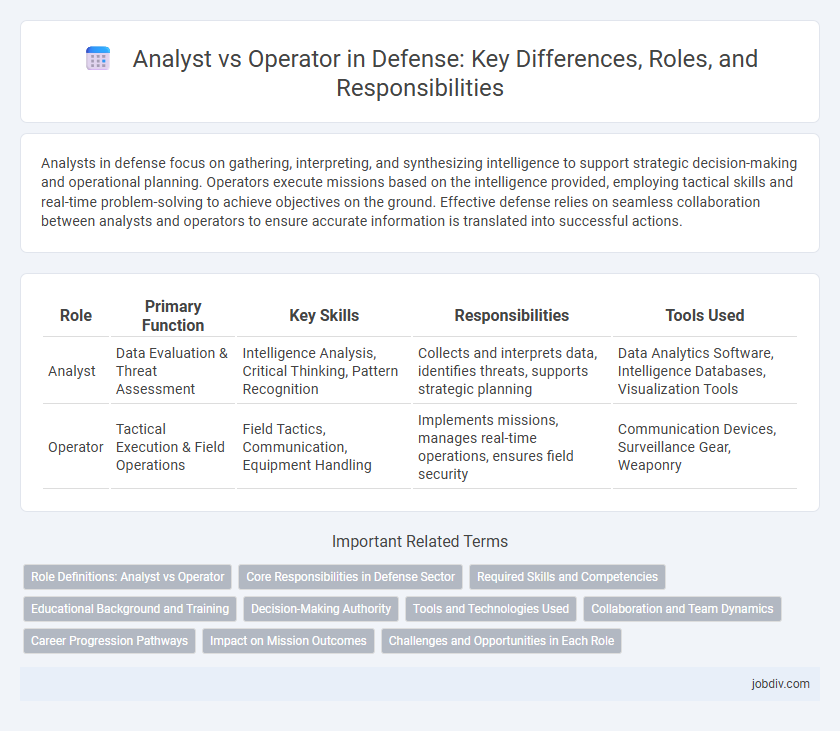Analysts in defense focus on gathering, interpreting, and synthesizing intelligence to support strategic decision-making and operational planning. Operators execute missions based on the intelligence provided, employing tactical skills and real-time problem-solving to achieve objectives on the ground. Effective defense relies on seamless collaboration between analysts and operators to ensure accurate information is translated into successful actions.
Table of Comparison
| Role | Primary Function | Key Skills | Responsibilities | Tools Used |
|---|---|---|---|---|
| Analyst | Data Evaluation & Threat Assessment | Intelligence Analysis, Critical Thinking, Pattern Recognition | Collects and interprets data, identifies threats, supports strategic planning | Data Analytics Software, Intelligence Databases, Visualization Tools |
| Operator | Tactical Execution & Field Operations | Field Tactics, Communication, Equipment Handling | Implements missions, manages real-time operations, ensures field security | Communication Devices, Surveillance Gear, Weaponry |
Role Definitions: Analyst vs Operator
Analysts in defense specialize in gathering, interpreting, and synthesizing intelligence data to support strategic decision-making and mission planning. Operators execute tactical missions, leveraging the intelligence provided to conduct direct actions, reconnaissance, and engagement with adversaries in real-time environments. The synergy between analysts' information processing and operators' field execution enhances operational effectiveness and mission success in defense operations.
Core Responsibilities in Defense Sector
Analysts in the defense sector focus on gathering intelligence, evaluating threats, and providing actionable insights to support strategic decision-making. Operators execute tactical missions, manage defense systems, and ensure operational readiness on the ground. The synergy between analysts' data-driven assessments and operators' field capabilities is vital for effective defense operations.
Required Skills and Competencies
Analysts require strong critical thinking, data interpretation, and cyber threat intelligence skills to assess and predict enemy movements effectively. Operators need advanced tactical proficiency, physical fitness, and quick decision-making abilities to execute missions in high-pressure environments. Both roles demand exceptional communication skills and situational awareness to ensure mission success and team coordination.
Educational Background and Training
Analysts in defense typically possess advanced degrees in fields such as intelligence studies, political science, or cybersecurity, combined with extensive training in data analysis and threat assessment techniques. Operators generally undergo rigorous military training, including combat tactics, weapons proficiency, and mission-specific skill development, often enhanced by specialized courses relevant to their tactical roles. Both roles require continuous professional education, with analysts focusing on cognitive and technical skills while operators emphasize physical readiness and operational expertise.
Decision-Making Authority
Analysts provide critical intelligence assessments that shape strategic understanding but typically lack direct decision-making authority in operational contexts. Operators leverage real-time intelligence and hold command roles, enabling them to execute decisive actions on the battlefield. The clear delineation of decision-making authority ensures that analysts inform while operators act, optimizing mission outcomes.
Tools and Technologies Used
Analysts deploy advanced data analytics platforms, including geospatial intelligence software and machine learning algorithms, to interpret vast amounts of information and generate actionable insights. Operators utilize real-time mission systems, secure communication devices, and tactical hardware such as drones and surveillance equipment to execute strategic operations effectively. Both roles rely heavily on integrated command and control systems to ensure seamless information flow and decision-making in defense environments.
Collaboration and Team Dynamics
Analysts provide critical intelligence by interpreting data and identifying threats, enabling operators to execute precision missions with informed situational awareness. Effective collaboration between analysts and operators strengthens team dynamics by fostering real-time communication, trust, and adaptive decision-making in complex defense environments. Integrating analytical insights with operational expertise enhances mission success and resilience against evolving security challenges.
Career Progression Pathways
Analyst roles in defense prioritize data interpretation, intelligence gathering, and strategic assessment, forming a foundational knowledge base essential for operational decision-making. Operator positions emphasize direct deployment, tactical execution, and mission leadership, often requiring advanced training and field experience. Career progression typically advances from analyst to operator roles, leveraging analytical expertise to enhance operational effectiveness and command capabilities.
Impact on Mission Outcomes
Analysts provide critical intelligence that shapes strategic decision-making, enabling operators to execute missions with precision and reduced risk. Operators translate analytical insights into tactical actions on the ground, directly influencing mission success through real-time adaptability and skillful engagement. The synergy between analysts and operators enhances situational awareness, accelerates threat response, and significantly improves overall mission outcomes.
Challenges and Opportunities in Each Role
Analysts in defense face challenges such as processing vast amounts of intelligence data and ensuring accuracy under tight deadlines, while opportunities include leveraging advanced analytics and artificial intelligence to enhance threat detection. Operators contend with high-pressure decision-making in dynamic environments and maintaining operational security, with opportunities to utilize cutting-edge technology and real-time intelligence to improve mission effectiveness. Both roles require continuous adaptation to evolving threats and collaboration to achieve strategic defense objectives.
Analyst vs Operator Infographic

 jobdiv.com
jobdiv.com